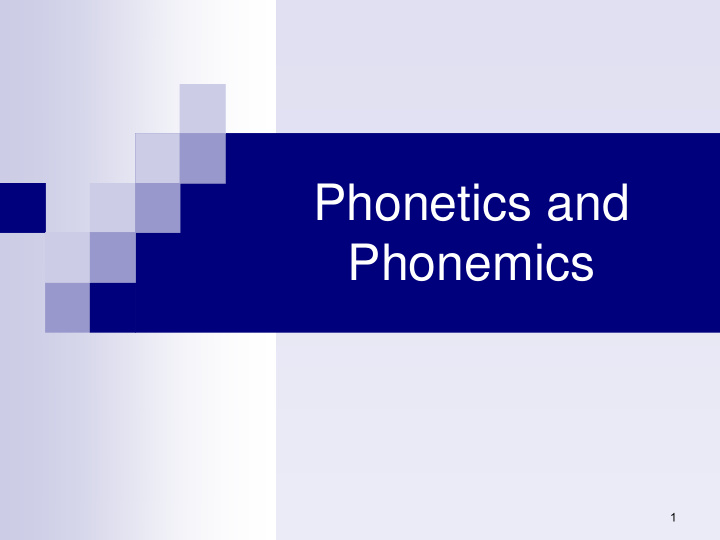



Phonetics and Phonemics 1
Phonetics and Phonemics : The principle goal of Phonetics is to provide an exact description of every known speech sound Domain of phonetics is independent of any particular language Phonemics is used for the study of speech sounds as they are perceived by speakers of a particular language 2
Phonetics : Articulatory phonetics How any given speech sound is produced, with particular emphasis on anatomical detail Acoustic phonetics The emphasis is on observable, measurable characteristics in the waveform of speech sounds Provides theoretical and experimental background for speech recognition and synthesis by electronic hardware 3
Articulatory phonetics : The first task of articulatory phonetics is to describe speech sounds in the terms of position of the vocal organs Phonetic alphabet Phoneticians have had to devise their own system of notation IPA ARPAbet 4
Excitation Of The Speech System Phonation Whispering Frication Compression Vibration 5
Articulatory phonetics (consonants) Consonants are easy to define in anatomical terms Point of articulation is the location of the principal constriction in the vocal tract Bilabial Labiodental Apicodental Apicogingival Apicoalveolar Apicodomal Laminoalveolar Laminodomal Centrodomal Dorsovelar Pharyngeal Glottal
… Consonants: Manner of articulation: the degree constriction at the point of articulation and the manner of release into the following sound Plosive Aspirated Affricative Fricative Lateral Semivowel Nasal Trill 7
… Consonants: Voicing: this indicates the presence or absence of phonation Voiced Unvoiced 8
Articulatory phonetics (vowels) : Vowels: vowels are much less well defined than consonants, this because tongue typically never touches another organ and vowels described by Tongue high or low Tongue front or back Lips rounded or unrounded Nasalized or unnasalized Diphthongs: combined two vowel sound in a single syllable by moving tongue from one position to another 9
Articulatory phonetics : Coarticulation: No speech sound is produced accurately in the context of other sound Overlapping of phonetic features from phone to phone is termed coarticulation 10
Phonemics : Phonetics is a view of speech sounds independent of the language Phonemics is the view of speech sounds within a specific language Phonemes Phonetics: an individual sound is a phone Phonemics: the smallest meaningful unit in a specific language is the phoneme 11
Phonemics (phonemes) : A phoneme is the smallest sound unit in a given language that is sufficient to differentiate one word from another Example: In English, Voicing is a feature which distinguishes between two phonemes ‘ bug ’ contrast with ‘ buck ’ In some contexts voicing is not phonemics in German ‘ Tag ’ can be pronounced either [ta:g] or [ta:k] 12
World ’ s languages tree (Oxford Encyclopedia) 800 million SINO-TIBETAN 1,500 million 150 million Burmese Chinese SEMITIC and Related INDO-EUROPEAN * Thai Arabic Tibetan Ethiopic 150 million … Hamitic BANTU and Related Hebrew … Swahili 140 million Zulu … MALAY-POLYNESIAN Hawaiian 130 million 100 million Indonesian Maori JAPANESE-KOREAN URAL-ALTAIC … Finnish Hungarian 45 million 130 million Mongolian Turkish SOUTH-ASIAN DRAVIDIAN … Vietnamese Malayalam, Tamil, Telugu 10 million Khmer … LATIN-AMERICAN INDIAN … Quechua 10 million 60,000 Guarani NORTH-AMERICAN Eskimo-Aleut Arawak INDIAN Carib … Aztecan, Algonquin, Iroquoian, Sioan, …
World ’ s languages tree (Cont ’ d ) Indo-Iranian Afghan Bengali Germanic Armenian Hindi Dutch, Flemish Kurdish English Persian German Sanskrit Albanian Scandinavian Singhalese Danish Urdu Icelandic … Norwegian Swedish Romance Yiddish Italian French Hellenic Portuguese Greek Romanian Spanish … Celtic Slavic Breton Bulgarian Irish Gaelic Czech Welsh Macedonian … Polish Russian Baltic Serbo-Croatian Lithunian Slovak Lettish Slovene Ukrainian …
15
16
Phonemics (phonemes) : The largest number of phoneme known is 45 in Chipewyan , the smallest is 13 in Hawaiian English has 31 to 64 and Persian has 29 to 45 phonemes, depending on how they are analyzed 17
Phonemics (Allophones) : A phoneme is actually a set of phonetically similar sound which are accepted by the speakers of the language as being the same sound. Members of the set are called allophones. Example: The /k/ in “ kin ” and “ cup ” . The /k/ in “ cope ” and “ scope ” . 18
English Phonemes uw ux uh ah ax ah-h aa ao ae eh Vowels ih ix ey iy ay ow aw oy er axr el y r l el w Semi-vowels jh ch s z sh zh f v th dh Fricatives m n ng em en eng nx Nasals b d g p t k dx q Stops bcl dcl gcl pcl tcl kcl hv hh Aspiration 19
Parsian Phonemes اه يراجفنا اه هكاو ب b i پ ي ،هي p ط ،ت e t د d هب، a ك c u ك ( k ) و و گ o و، گ ( g ) آ،ا غ،ق G ءع ، 20
Parsian Phonemes (Cont ’ d) اه يشياس يراجفنا اه يشياس d ج ف f چ و t v ص ،س ،ث اه هكاو هبش s l ل ظ ،ض ،ذ ،ز Z ر ش r م ژ m ن خ n ح ،ه ي ،هي j h 21
Phonemes in Persian دنب ميسقتىسراف رد اهجاوىم ماجنا فلتخم لاكشا هبىدريگ . ندوب ناتسيا نازيم ساسا رب اجنيا رد م تروصىدريگ . موادم continuant اه هكاو اه ناوخمه vowels consonants نيشيپ نايمى نيسپ front mid back ئى ا آ ا ا وا شياسى ئاوجنى موشيخى fricative whisper nasal هح ن م رادكاو كاويب voiced unvoiced ژ ز وغ ش س فخ
Phonemes in Persian (cont ’ d) موادم ريغ non continuant شياس همينى اه هكاوىبيكرتى اه هكاو ههبش اه هفقو diphthongs semivowels affricate plosives چ ج اىوا اهيشزرل اهناور رادكاو كاويب liquids glides voiced unvoiced ل ر ى گ د ب ك ت پءق ع * ناور جاو / و / اهنابز ردىبرعى ك ودرىم هدافتساىلو دوشىسراف ردىتسا هدش شومارف ابيرقت ضعب رد طقف وىاه هجهل زاىسرافىم هدافتساىدوش .
24
25
26
Recommend
More recommend